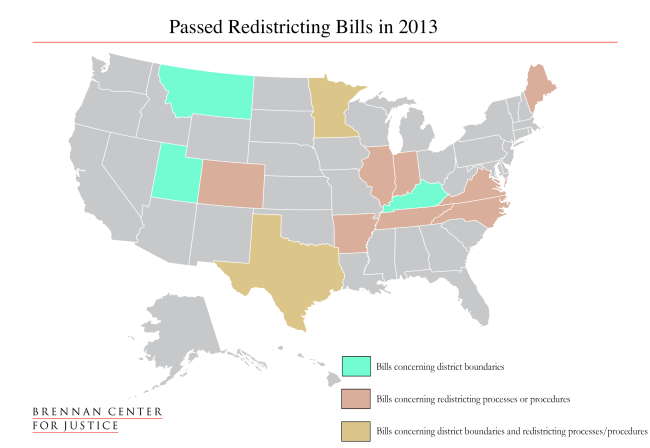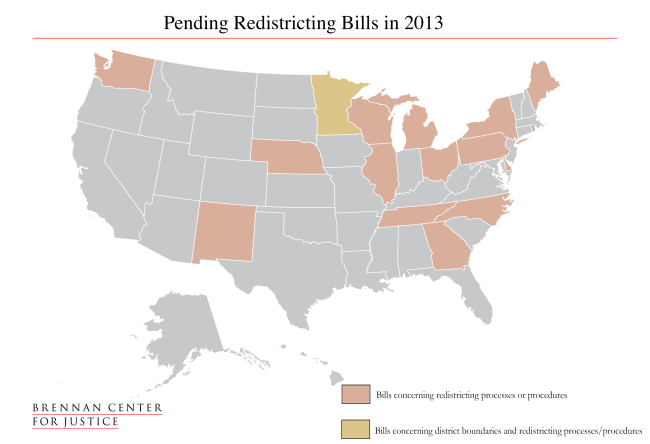Redistricting, the carving of state legislative and congressional district boundaries, occurs every 10 years. The responsibility for redrawing districts lies with the states rather than the federal government.
Although the next redistricting cycle is in 2020, following the contentious battles over redrawing district lines during 2010, many states have begun efforts to comprehensively alter or reform the process. Other states have simply passed or proposed legislation with minor changes such as deadlines, data handling protocols, transparency requirements, litigation payments, or precinct adjustments, among others. Nevertheless, in most states, no alterations to redistricting procedures were passed in 2013.
This page summarizes the redistricting legislation that passed this year, and others that are still pending.
Overview of Passed Bills
During the 2013 state legislative sessions, as of November 18, 2013:
- 24 redistricting related bills passed in 13 different states[1]
- Of these, 11 bills in five states involve either drawing, adjusting, or modifying various district boundaries[2]
- 13 bills in 10 states entail changes to redistricting processes or procedures[3]
The map below illustrates the states that have passed redistricting related bills divided into two categories: bills regarding district boundaries and bills concerning redistricting processes and procedures.

District Boundaries | Redistricting Processes or Procedures | Both District Boundaries and Processes/Procedures |
Kentucky | Arkansas | Minnesota |
Minnesota | Colorado | Texas |
Montana | Illinois |
|
Texas | Indiana |
|
Utah | Maine |
|
| Minnesota |
|
| North Carolina |
|
| Texas |
|
| Tennessee |
|
| Virginia |
|
List of Passed Bills Involving Changes to Redistricting Processes or Procedures
Arkansas
- One bill passed that requires precincts to be redistricted if the population of a single precinct exceeds 3,000 voters.
Colorado
- A bill passed that creates the legislative department cash fund-redistricting account in the state treasury.
Illinois
- A Senate resolution passed that outlines the rules for the internal operations and procedures of the state Senate. It eliminates the Redistricting Standing Committee.
Indiana
- Two redistricting bills passed in Indiana this year.
- The first bill urges the legislative council to establish an interim study committee to examine whether county governments can be modified to place (1) all executive powers in a single county executive rather than a board of commissioners and (2) all legislative and fiscal powers in a county council.
- The second bill specifies that any conflict between a precinct map and the description of the precinct set forth in the precinct establishment order is to be resolved in favor of the description in establishment order. It also requires the census data advisory committee to study standards for determining residency, allegations of voter suppression and election fraud, and methods for reducing lines at polling locations, among other election-related concerns during the 2013 legislative interim.
Maine
- A bill passed that shifts the commencement of redistricting from the third year of each decade to the first year of the decade. The previous law stated that redistricting should occur in “1993 and every 10 years thereafter,” whereas now it will happen in “2021 and every 10 years thereafter.” The Legislative Apportionment Commission also has to submit the plan to Clerk of the state House of Representatives no later than “June 1st of the year” that apportionment is required. Under the previous law, it had to submit the plan “120 days after the convening of the Legislature.”
Minnesota
- Two companion appropriations bills passed that allocate $355,000 to the Secretary of State for attorneys fees as ordered by the court in the redistricting case Hippert et al v. Ritchie et al.[4]
North Carolina
- In North Carolina, certain information from the redistricting process, such as drafting requests to and documents prepared by legislative employees, becomes part of the public record after new district plans become law. However a bill passed this year carves out an exemption for attorney-client privileged work and common law work product doctrine with respect to legislators, from this transparency initiative.
Tennessee
- Two companion bills passed that establish new duties for the Office of Local Government, requiring it to maintain geographic and redistricting data that may be utilized to assist and advise local governments with redistricting and reapportionment. In addition, the office is directed to serve as a liaison with the United States Census Bureau in order to garner geographic and redistricting data for the state.
Texas
- One bill passed which mandates that county election precincts may not contain territory from more than one out of the following territorial units: a commissioner’s precinct, justice precinct, Congressional district, state Representative district, Senatorial district, and state board of education district.
Virginia
- A bill passed that allows localities the option to initiate prison-based gerrymandering reform. Any county, city or town with a correctional facility may exclude the prison population from that locality for the purpose of the census. Consequently adult inmates in correctional facilities may be counted as residents of their districts of origin. This law and its predecessor, HB 13, do not effect state-level redistricting.
Pending Bills[5]
During the 2013 state legislative sessions, as of November 18, 2013:
- 50 redistricting bills are pending in 15 states[6]
- Of these, seven bills in one state involve either drawing, adjusting, or modifying various district boundaries[7]
- 43 bills in 15 states entail changes to the redistricting processes and procedures[8]
Of all pending bills, only 13 out of 50 bills, or 26 percent, have moved beyond the committee phase of the legislative process. And of the bills that change the redistricting process or procedure, only 8 out of 43, or just shy of 19 percent, have passed their respective committee.
The map below illustrates the states that have pending legislation related to drawing or modifying district boundaries, and redistricting processes and procedures.

District Boundaries | Redistricting Processes or Procedures | Both District Boundaries and Processes/Procedures |
Minnesota | Delaware | Minnesota |
| Georgia |
|
| Illinois |
|
| Michigan |
|
| Minnesota |
|
| Nebraska |
|
| New Mexico |
|
| New York |
|
| North Carolina |
|
| Ohio |
|
| Pennsylvania |
|
| Rhode Island |
|
| Tennessee |
|
| Washington |
|
| Wisconsin |
|
Summary of Pending Bills Involving Changes to Redistricting Processes and Procedures
Compliance with constitutional mandates
- There are two bills in one state that requires congressional redistricting plans to comply with the U.S. Constitution and the state constitution.[9]
Implications for racial minorities
- Three bills pending in one state that includes language that may make it more difficult for minority communities to equally participate in the political process and elect candidates of their choice. These bills prohibit the construction of districts that dilute or augment the voting strength of minority communities, except as may be necessary to comply with other criteria such as the U.S. Constitution and the federal Voting Rights Act. Moreover, the bills prohibit the use of data regarding race or ethnicity except to meet the standards of the U.S. Constitution and the federal Voting Rights Act.[10]
Implications for communities of interest
- There is one bill in one state that limits the ability of communities of interest to be considered in crafting state legislative or congressional district lines.[11] The bill prohibits districts from being drawn to favor a political party, incumbent legislator or Congressman but also extends the prohibition to prevent any district lines from diluting or augmenting the voting strength of a community of interest.
Precincts
- There is one bill pending in one state that redefines the size and composition of voting precincts.[12]
Prison-Based Gerrymandering
- Four bills have been introduced in two states that require the state Department of Corrections to collect data on the last known legal residence of inmates, with additional requirements that the adjusted data be utilized for the construction of local and state House and Senate districts.[13]
Redistricting commissions and criteria
- At least 28 bills are pending in 11 states that seek to reduce the role of partisanship in the redistricting process. Some bills strip the legislature of the responsibility for redistricting and allocate it to independent commissions composed of unelected officials. Others create joint responsibilities between the legislature and a commission. Commissions have been proposed in diverse forms including politician, advisory, back-up and independent. In addition, frequently attached to these proposed shifts in the body that performs redistricting are standards that constrain the actors. In some instances, the bills only define or rank such criteria without changing the responsibility for who performs redistricting.
- There are six bills in three states that establish redistricting principles without simultaneously creating a commission.[14] Criteria for drawing districts include equal population, contiguity, competitiveness, nesting, congruence with federal and state laws and constitutions, prohibitions on diluting the voting strength of minority populations, prohibitions on drawing districts to favor or disfavor political parties or incumbents, and preserving communities of interest, among others. Several of the bills also outline mandates for transparency and public participation in the redistricting process.[15]
Redistricting Data
- There is one bill introduced in one state that establishes new procedures for the collection of demographic data, and mandates the construction and integration of new databases with information about local district boundaries, voter registration and elections.[16]
Transparency
- Two bills have been introduced in two states to generate greater transparency during the redistricting process, including required public hearings, comment periods and adequate notifications of hearings or changes to district lines.[17]
[1] Arkansas, Colorado, Illinois, Indiana, Kentucky, Maine, Minnesota, Montana, North Carolina, Tennessee, Texas, Utah, and Virginia
[2] Kentucky, Minnesota, Montana, Texas, and Utah
[3] Arkansas, Colorado, Illinois, Indiana, Maine, Minnesota, North Carolina, Tennessee, Virginia, and Texas
[4] Technically HF 1184 did not pass and was substituted for SB 1589, which did pass and become public law.
[5] Pending bills are defined as bills that are currently pending in ongoing legislative sessions, as well as bills in states where the legislative session is over but the bills will be carried over into the 2014 session.
[6] Delaware, Georgia, Illinois, Michigan, Minnesota, Nebraska, New Mexico, New York, North Carolina, Ohio, Pennsylvania, Rhode Island, Tennessee, Washington, and Wisconsin.
[7] Minnesota
[8] Delaware, Georgia, Illinois, Michigan, Minnesota, Nebraska, New Mexico, New York, North Carolina, Ohio, Pennsylvania, Rhode Island, Tennessee, Washington, and Wisconsin
[9] Tennessee
[10] North Carolina
[11] Michigan
[12] Illinois
[13] Illinois and Rhode Island
[14] Illinois, Washington, and Wisconsin
[15] Delaware, Georgia, Illinois, Michigan, Minnesota, New Mexico, New York, Ohio, Pennsylvania, Washington, Wisconsin
[16] Pennsylvania
[17] Nebraska and New York